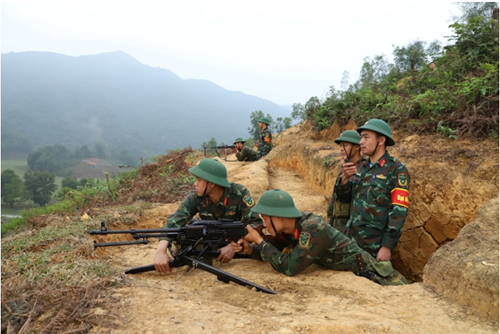In order to successfully accomplish assigned missions, the Command of the campaign resolved issues related to the art of operation and tactics. Implementing the combat strategy “steady attack, steady advance,” military units participating in the campaign made thorough preparations in all aspects, gradually built stronger fortifications, divided, cut off and destroyed the enemy.
Regarding combat tactics, the units well implemented the campaign’s intentions in each battle and each phase of the campaign. Our troops built stronger fortifications, dug deeper trenches to move closer to the French base and deployed towed artillery batteries on a large scale. The artillery force provided covering fire for the infantry force to steadily attack and capture terrain; used anti-aircraft guns to strike back at the enemy and limit the activities if its aircraft.
The development of tactics in the Dien Bien Phu Campaign was also shown in defensive battles. Our troops took advantage of terrain, actively renovated the enemy’s old battlefields to build defensive battlefields; used more firepower than troops; concentrated mobile reserve forces to completely destroy each group of targets in the outer circle. The issues related to the art of attacking the Dien Bien Phu stronghold have precious values in both theory and practice.
Researching and developing tactical theory at the section level
The Army Officer Candidates School No.1 is a center offering the bachelor training program to graduate sectional-level command-staff officers. Training is the process of transferring combat experience and good traditions of the unit and the military to cadets; therefore, the historical significance and practical lessons, especially the art of offensive against strongholds in the Dien Bien Phu, have remained valuable in the school’s education and training.
    |
 |
|
Combined all-round tactical exercise with live-fire content for third-year cadets of the K89 course of the Army Officer Candidates School No.1 |
The school has actively studied the enemy at the Dien Bien Phu stronghold - a new defense form of the enemy, that is defense in solid fortifications, with a diverse system of obstacles in different types and complicated layouts; flexible combat tactics; supported by artillery and air forces; close coordination in combat, among others.
Meanwhile, the school has focused on studying offensive operation on Him Lam and Doc Lap fortifications to draw experience and lessons, and apply them to researching fighting measures, ways to penetrate the fortification, preparations and combat practice, to name but a few.
Applying to tactical training
Tactical training is an important subject in the bachelor training program to graduate sectional-level command-staff officers at the Army Officer Candidates School No.1. The school has always attached significance to tactical training and closely combined theory with practice.
During tactical training, the school has combined imparting knowledge with sharing combat experience, in which flexibly and creatively apply the art of attacking Dien Bien Phu stronghold to each form of tactics, each level of squad, platoon, company and battalion to clarify the relation between the theoretical principles and the practice of training and combat. Therefore, cadets can be equipped with basic knowledge, tactical thinking capability, and creative and resolute command methods and style, creating a basis for future management, command and training.
For lectures on tactical principles, lessons drawn from battles in the past; ways to encircle, encroach, attack and destroy the enemy; the combat strategy of “steady attack, steady advance” in the Dien Bien Phu Campaign are vivid evidence for cadets. In tactical practice, the school has directed the Department of Tactics, the Department of Reconnaissance, and the Department of Arms and Services to conduct research on the organization of defense positions in the fortifications of Dien Bien Phu strongholds to flexibly and creatively apply it to drawing up tactics and training methods, and compiling lectures; design and build training grounds and arrange targets for blockhouses, gun emplacements, communication trenches, as well as set up obstacles to ensure the practicality of training work.
Meanwhile, the school has paid attention to conducting the training content of field reconnaissance; evaluated formation organization, the nature of fortification, obstacles and firepower, and fighting tricks of the enemy; applied combat tactics; closely coordinated with higher levels and local armed forces in the defensive area to continuously attack in many directions, breaking the enemy’s defensive.
The school’s cadets have been trained to make full use of the terrain and on-site materials to build strong fortifications to withstand the enemy’s fire and equipped with methods of collaborating with other forces in the combat area to thoroughly grasp situational developments; and ways to give the alarm for units to prevent and fight back against the enemy’s fire attacks in a strong electronic warfare environment; to name but a few.
Additionally, the school’s board of directors has required agencies and departments to do research to build exercise plans with various combat tasks and forms of tactics, including shifting combat readiness status, marching to rendezvous site, and crossing the river with weapons, etc.
Cadets must maneuver through complicated terrains under all weather conditions both day and night to adapt to the most difficult and harsh conditions. During the combined all-round tactical exercises, the school has conducted many practice forms of tactics, such as attacking airborne enemy troops, ambushing, and attacking the enemy in solid fortifications, among others.
Lieutenant General, Assoc. Prof., Dr. Do Viet Toan, Rector of Army Officer Candidates School No.1
Translated by Quynh Oanh